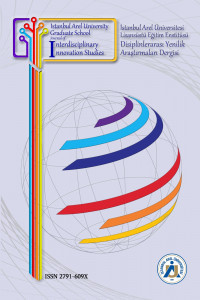Türkiye’de uydudan internete doğru gelişen Televizyon yayıncılık iletim teknolojisinde 5G kullanımı
5G’nin yaygın olarak kullanılmasıyla birlikte sadece endüstride ve üretim-tüketim biçimlerinde değil, teknolojinin kullanıldığı her alanda değişikliklerin olması öngörülmektedir. Bunların başında ise televizyon yayıncılığı gelmektedir. 5G teknolojisinin getirdiği yüksek kapasiteli ve düşük gecikmeli veri iletim imkânı yayıncılık sektöründe farklı deneyimlerin kapısını açmaktadır. Böylelikle, uydu yayınlarının devre dışı bırakılmasıyla birlikte televizyon işletmelerinin iletim maliyelerinde düşüş, izleyicilerin izleme konforunda artış, uydu kapasitelerinin efektif kullanılması, çevre ve görüntü kirliliğine yol açan ekipmanların da kaldırılmasıyla daha temiz ve güzel bir çevre oluşması öngörülmektedir. Bu çalışmada, uydu yayıncılığına alternatif olarak 5G teknolojisine dayalı iletim şeklini inceleyerek kullanıcıların davranışlarına göre maliyeti düşürmeye yönelik önerilerde bulunmaktayız.
Anahtar Kelimeler:
5G, television, satellite, broadcast.
Television Broadcasting Communication Technology from Satellite to Online TV in 5G: A Case Study for Turkey
With the widespread use of 5G, it is predicted that there will be changes not only in industry and production-consumption forms but also in every field where technology is used. Television broadcasting comes first among them. The high-capacity and low-latency data transmission opportunity brought by 5G technology will open the door to different experiences in the broadcasting industry. Thus, with the disabling of satellite broadcasts, it is predicted that a cleaner and more beautiful environment will be created by reducing the transmission costs of television enterprises, increasing the viewing comfort of the audience, using satellite capacities effectively, and removing equipment that causes environmental and visual pollution. In this study, we examine the 5G-based transmission method as an alternative to satellite broadcasting and make suggestions to reduce the cost according to the behavior of the users.
Keywords:
5G, television, satellite, broadcast.,
___
- [1] Gomez-Barquero D, Li W, Fuentes M, Xiong J, Araniti G, Akamine C ve Wang J. “IEEE Transactions on Broadcasting Special Issue on: 5G for Broadband Multimedia Systems and Broadcasting”. IEEE Transactions on Broadcasting, 65(2), 351-355, 2019.
- [2] Bilgi Teknolojileri ve İletişim Kurumu. “5G ve Ötesi Beyaz Kitap”. https://btk.gov.tr/uploads/announcements/5g-ve-otesi-beyaz-kitap/5g-ve-otesi-beyaz-kitap.pdf (14.01.2021).
- [3] Jawad N, Salih M, Ali K, Meunier B, Zhang R, Zhang X, Zetik R, Zarakovitis C, Koumaras H, Kourtis MA, Shi L, Mazurczyk W ve Cosmas J. “Smart Television Services Using NFV/SDN Network Management”. IEEE Transactions on Broadcasting, 65(2), 404-413, 2019.
- [4] Kishigami J. "The Role of QoE on IPTV Services style". Ninth IEEE International Symposium on Multimedia, Taichung, Taiwan, 2007. doi: 10.1109/ISM.2007.4412350.
- [5] Kourtis M A, Blanco B, Pérez-Romero J, Makris D, Mcgrath M J, Xilouris G, Munaretto D, Solozabal R, Sanchoyerto A, Giannoulakis I, Kafetzakis E, Riccobene V, Jimeno E, Kourtis A, Ferrús R, Liberal F, Koumaras H ve Kostopoulos A. “A Cloud-Enabled Small Cell Architecture in 5G Networks for Broadcast/Multicast Services”. IEEE Transactions on Broadcasting, 65(2), 414-424, 2019.
- [6] Evans B, Onireti O, Spathopoulos T ve Imran MA. “The Role of Satallites in 5G”. ASMS/SPSC, Nice, France, 8-10 Sep. 2014.
- [7] Yarali A ve Cherry A. “Internet Protocol Television (IPTV)”. TENCON 2005-2005 IEEE Region 10 Conference, Melbourne, VIC, Australia, 2005. doi: 10.1109/TENCON.2005.300861.
- [8] Magri M and Iano Y. “How to architect an IPTV system”. Eighth International Workshop on Image Analysis for Multimedia Interactive Services, Santorini, Greece, 2007. doi: 10.1109/WIAMIS.2007.49.
- [9] Ge C, Wang N, Selinis I, Cahill J, Kavanagh M, Liolis K, Politis C, Nunes J, Evans B, Rahulan Y, Nouvel N, Boutin M, Desmauts J, Arnal F, Watts S ve Poziopoulou G, “QoE-Assured Live Streaming via Satellite Backhaul in 5G Networks”. IEEE Transactions on Broadcasting, 65(2):381-391, 2019.
- [10] Michael K. “SpaceX Confident About Its Starlink Constellation for Satellite Internet; Others, Not So Much”. https://spectrum.ieee.org/aerospace/satellites/spacex-confident-about-its-starlink-constellation-for-satellite-internet-others-not-so-much. IEEE Spectrum, 2019.
- [11] Han H, Cai Y, Zhang J. Sharing C-band Frequency Between Satellite and Terrestrial 5G Communication Systems. Eds: Wang Y, Xu L, Yan Y, Zou J. Signal and Information Processing, Networking and Computers. Lecture Notes in Electrical Engineering, vol 67, Springer, Singapore, 2020. https://doi.org/10.1007/978-981-33-4102-9_12
- [12] Gomez-Barquero D, Lee JY, Ahn S et al. “IEEE Transactions on Broadcasting Special Issue on: Convergence of Broadcast and Broadband in the 5G Era”. IEEE Transactions on Broadcasting, 66(2), 383-389, 2020. doi: 10.1109/TBC.2020.2985493.
- [13] Balaš T. TV Broadcasting in 5G. Doctoral dissertation, University of Dubrovnik, Dubrovnik, Crotia, 2021.
- [14] Qiang H. “Consumption Reduction Solution of TV News Broadcast System Based on Wireless Communication Network”. Complexity, Article ID 9936803, 13 pages, 2021. https://doi.org/10.1155/2021/9936803.
- [15] Bilgi Teknolojileri ve İletişim Kurumu. “The State of Internet in Q4 2018”. https://wearesocial.com (18.02.2021).
- [16] Türkiye İstatistik Kurumu (TÜIK). “Hane Halkı İnternet Kullanımı”. https://tuikweb.tuik.gov.tr/PreHaberBultenleri.do?id=33679 (26.02.2021).
- [17] Radyo ve Televizyon Üst Kurulu (RTÜK). “Televizyon İzleme Eğilimleri Araştırması”. https://www.rtuk.gov.tr/assets/Icerik/AltSiteler/televizyon-izleme-egilimleri-arastirmasi-20060053.pdf (26.02.2021).
- [18] Ünaldı A. Televizyon Teknolojilerinde Doping Etkisi, CreateSpace Independent Publishing Platform, Kaliforniya, ABD, 2015.
- [19] Türksat Uydu Haberleşme Kablo TV ve İşletme A.Ş. “Konu”. https://www.turksat.com.tr (25.11.2020).
- Yayın Aralığı: Yılda 2 Sayı
- Başlangıç: 2021
- Yayıncı: İstanbul Arel Üniversitesi
Sayıdaki Diğer Makaleler
Ahmet TURHAN, Nurdan ÇOLAKOĞLU
Yenilikçi Girişimcilik ve Hizmet Endüstrisinin Gelişimi: Makro İktisadî Bir Perspektif
Türkiye’de uydudan internete doğru gelişen Televizyon yayıncılık iletim teknolojisinde 5G kullanımı
Ünal DOĞAN, Zhaleh SADREDDİNİ, Gökalp TULUM
Aysegul DONMAZ, Ayse AKYOL, Gulhayat GOLBASI SIMSEK
Güneş enerjisi ile elektrik üretiminde örnek uygulamalar
Cumhuriyetin 100. Yılında Türkiye’de demiryolu ulaşımı
Hakan ÇETİNOĞLU, Levent DALYANCI
Ahmet TERZİ, Bahşende TAŞDEMİR
Koronavirüs salgın kaynağına farklı bir bakış: domuz ve ürünleri vektör olabilir mi?
